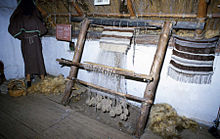Loom weight
Weaving weights are used in prehistoric , antique and medieval weight looms to tension the warp threads .
In the context of archaeological finds, only the loom weights made of lithic or ceramic material are usually preserved from looms. Mostly they consist of coarse fired clay. While the wooden parts of the loom have passed, the weights in pit houses are occasionally still in a row next to each other as they were attached to the loom. The shapes are different, ring-shaped, conical and pyramidal specimens are known. Loom weights are always provided with a hole to attach the warp threads.
Florian M. Müller does not rule out the use of loom weights in rituals , similar to the spindle whorls .
literature
- Klaus Tidow: weaving, loom, weaving sword . In: Johannes Hoops (original): Reallexikon der Germanischen Altertumskunde (2nd ed.) Vol. 33, 2006, p. 322 – p. 327.
- Florian Martin Müller : Considerations on the function, decorations and contexts of finding Daun weaving weights . In: Raimund Karl, Jutta Leskovar (Hrsg.): Interpretierte Eisenzeit. Case studies, methods, theory - 2nd Linz Conversations on Interpretative Iron Age Archeology, Linz 2007, pp. 291–303, ISBN 978-3-85474-174-9 (Studies on the cultural history of Upper Austria 19)
- Florian Martin Müller: A collection of loom weights from the area of the central hilltop of Colle Serpente in Ascoli Satriano (Foggia / Italy) . In: Gerald Grabherr, Barbara Kainrath, Astrid Larcher, Barbara Welte (eds.): Vis Imaginum. Festschrift for Elisabeth Walde on her 65th birthday , Innsbruck 2005, pp. 269-279, ISBN 3-200-00267-0 University of Innsbruck, PDF
